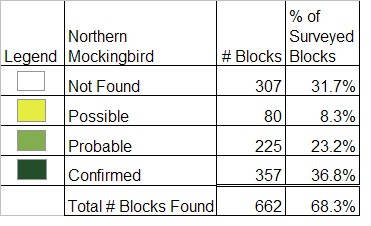Breeding Bird Atlases (BBA)
Find a Bird - BBA1
Breeding Bird Atlas 1 Species Accounts
Northern Mockingbird
Mimus polyglottos
Egg Dates
May 11 to August 22
Number of Broods
two

The Northern Mockingbird is a permanent resident in Massachusetts, but this was not always the case. It was considered a rare visitor in the state during the mid- to late 1800s. During the 1920s, Forbush reported that it had become less rare and that breeding was rare but regular—a status that remained unchanged for the next quarter-century. A gradual increase was noted during the 1950s and 1960s, which greatly accelerated during the 1970s. This growth and range expansion owed much to the widespread planting of Multiflora Rose since the 1930s and the growth of suburbia along the Atlantic coast.
As a breeder, the mockingbird is widely distributed in lowland portions of the state and is less common or absent at higher elevations in central and western Massachusetts. It favors nesting sites near yards, especially those with lawns, shrubs, vines, and conifers, and also inhabits brushy forest edges or clearings and farm hedgerows.
The mockingbird is a talented songster and a clever mimic. Frank M. Chapman—a noted twentieth-century ornithologist—considered its reputation for mimicry overrated; but Forbush described it as a “most gifted singer” whose song “equals and even excels the whole feathered choir.” Male mockingbirds often choose a prominent singing perch and during courtship may also hop, bound, flutter, and flash their wings. Songs are sometimes given in flight. In addition to its own varied notes, mockingbirds mimic other birds, insects, animals, human whistles, and even vehicle and machine noises. Various authors and growing numbers of unhappy sleepless auditors state that mockingbirds give their finest and most persistent vocal performances on moonlit nights during the nesting season. In Massachusetts, males sing occasionally at any time of year but are generally silent when they are molting. The common call note is a loud smack or chuck.
Male mockingbirds vigorously claim and defend breeding territories, sometimes fighting and other times using a ritualized dance involving hopping, stepping stiffly, raising the tail, and flashing the wings. Polygamy has also been documented for this species. Nesting habitats for 28 state nests were as follows: suburban (18 nests), old field (9 nests), orchard (1 nest) (CNR). Both sexes collect nesting material, including small twigs, grasses, rootlets, and dried leaves, but the female apparently does most of the actual construction. The bulky nest takes about two days to build and is generally placed in a vine, shrub, or ornamental plant. Thirty Massachusetts nests were located as follows: spruce (7 nests); Red Cedar (5 nests); pyracantha (4 nests); Arbor Vitae, maple, barberry, hawthorn (2 nests each); and grape, rose, White Birch, White Pine, mock-orange, and Beauty-bush (1 nest each) (CNR). The average nest height was 7 feet (CNR).
Clutches usually consist of four to five eggs (range three to six). The eggs are buff colored, greenish blue, or pale blue washed with shades of brown in blotches and spots. A pair raises two (sometimes three) broods yearly, and they will renest after a failure. The female incubates for 12 days or slightly longer, and, after the young have hatched, both parents participate in their feeding and care, dive-bombing any bird, animal, or human that approaches them. Nestlings have been observed in the state from May 11 to September 1. Known state hatch dates are May 21 and June 4, and 2 three-egg clutches were laid from May 18 to 20 and May 22 to 24, respectively (CNR). Dates for nestlings and fledglings indicate that eggs are to be expected earlier than the reported date of May 11. In Massachusetts, fledglings have been reported from May 13 to August 17.
The young fledge 10 to 12 days after hatching. Fledged young are browner in color than adults, but a partial molt involving the contour plumage and wing coverts, usually in September, produces a first winter plumage more like that of the adult birds. Adult mockingbirds undergo a complete postnuptial molt. Following nesting and molt, some adults remain to set up a winter territory in the area where they bred while others move varying distances. Most immatures engage in a migratory dispersal that is as likely to take them north as south; this dispersal results in a wintering population that is concentrated along the coast. When a mockingbird establishes a winter territory, it makes its presence known by monitoring its territory from a conspicuous perch throughout the day. If the territory is small, the occupant may attempt to drive other birds away from it, but individual mockingbirds are variable in this behavior.
Map Legend and Data Summary
Atlas 1 data collected from 1975-1979


Note: common at lower elevations, especially in residential areas
Helen C. Bates



